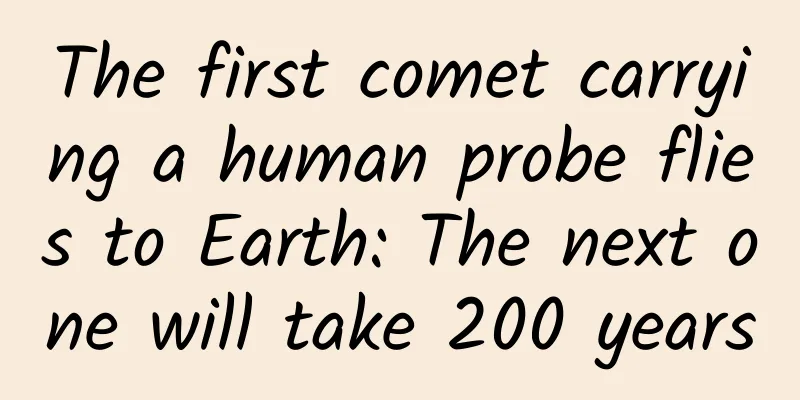The first comet carrying a human probe flies to Earth: The next one will take 200 years

|
On November 12, 2021, a comet carrying a human probe will fly past the Earth, with the closest distance being about 63 million kilometers (or 0.418 AU, AU: astronomical unit, 1AU is about 150 million kilometers). Comet 67P photographed on October 3, 2021 | Image source: Rolando Ligustri This is a periodic comet, whose full name is Churyumov-Gerasimenko, nicknamed 67P, and whose probe is called "Philae" (look carefully, it's not "leek"!). It is the lander carried by the comet exploration program "Rosetta" launched by the European Space Agency (ESA) in 2004. On November 12, 2014, exactly seven years ago, Philae successfully landed on the surface of Comet 67P, becoming the first spacecraft in history to land on a comet. After orbiting 67P for two years, Rosetta rested on the cold surface of the comet on September 30, 2016, ending its 12 and a half years of scientific exploration mission. Schematic diagram of the Rosetta comet probe and the Philae comet lander | Source: ESA This "close encounter" with the Earth will be the closest 67P will get to the Earth in this century and the next. The next close approach to the Earth will not come until 193 years later, in 2214. The past and present of Comet 67P 67P/ Churyumov-Gerasimenko was first discovered by Soviet astronomers Churyumov and Gerasimenko in 1969 and named after them. 67P has an aphelion distance of 5.68 AU, an orbital period of 6.45 years, an orbital inclination of 7.04 degrees, a rotation period of 12.4 hours, a mass of about 10¹³ kg, and an average density of 0.4 g/cm³. It is a typical Jupiter family comet. Jupiter-family comets are comets with an orbital period of less than 20 years, an aphelion distance close to the orbit of Jupiter, and an orbital inclination of no more than 30 degrees. Jupiter-family comets are generally believed to originate from the Kuiper belt beyond the orbit of Neptune. The objects in the Kuiper belt are occasionally ejected into the inner solar system after being gravitationally disturbed by the outer planets of the solar system, becoming Jupiter-family comets. Under the influence of the gravity of the Sun and Jupiter, the perihelion of 67P will continue to change. Before 1840, the perihelion distance of 67P was 4 AU, and it became 3 AU in 1840; in February 1959, a close encounter with Jupiter caused the perihelion of 67P to move inward to 1.29 AU; the most recent perihelion pass occurred on November 3, 2021, with a perihelion distance of 1.21 AU; and the next time the perihelion will undergo a major change will be November 2220, when 67P will fly by Jupiter at a distance of 0.12 AU, and its perihelion distance will become 0.8 AU. 67P's orbital position when it is closest to Earth on November 12, 2021 | Image credit: Greg Smye-Rumsby Rosetta's major scientific discoveries Surface characteristics Comet images taken by Rosetta show that the nucleus of 67P has two distinct lobed structures with an average diameter of 4.2 kilometers and the longest and widest dimensions of approximately 4.3 kilometers by 4.1 kilometers. The nucleus of Comet 67P | Image source: ESA/Rosetta/NAVCAM Comet 67P has a rough surface with cliffs, boulders, cracks, pits, dunes and ridges. From the images taken when Philae was descending before landing, the surface of the comet is covered with millimeter to meter-sized regolith and gravel. It is preliminarily estimated that the surface of the comet has a 10-20 cm thick regolith. Geomorphic divisions of the nucleus of Comet 67P | Image source: Thomas et al. (article [7]) 0Chemical composition Scientific detection by Rosetta shows that Comet 67P is a very loose combination of water ice, dust and rocks. The main components of the released gases are ammonia, methane, hydrogen sulfide, hydrogen cyanide and formaldehyde, so its smell is like a mixture of rotten eggs, horse urine, alcohol and bitter almonds. The deuterium content is an important probe of the formation and early evolution of the solar system. 67P has a very different water vapor composition from that of Earth, with a deuterium to hydrogen ratio three times that of Earth's oceans, which at least indicates that Earth's water is unlikely to have come from comets like 67P. A large amount of free molecular oxygen (O2) was found in the gas around 67P, which is the first time that O2 has been detected in a comet's coma. Regarding their origin, one view is that they were included in the comet's initial formation period, and another view is that they were produced when water molecules collided with silicates and other oxygen-containing substances on the comet's surface. Philae also detected 16 organic compounds on 67P, of which four, acetamide, acetone, methyl isocyanate and propionaldehyde, were discovered on a comet for the first time. 〇Activity As a Jupiter family comet, 67P's activity is mainly driven by the sublimation of water ice. In theory, for a comet with a uniform distribution of active areas, the rate of water ice generation gradually increases during the process of moving toward perihelion. However, Rosetta found that the active area on the surface of 67P's nucleus is uneven, and the water production rate increases sharply in the months before perihelion. The main reason may be that when 67P passes perihelion, it is summer in the southern hemisphere of the comet nucleus, causing heat to penetrate deep into the nucleus and the active area to expand accordingly. Rosetta also discovered near-nuclear structures such as jets inside the coma of 67P. These jets are related to specific areas on the surface of the nucleus. There are not only jets on the dayside but also jets on the nightside. However, due to the extremely irregular shape of the nucleus of 67P, the source of the jets is still unknown. The jet near the nucleus of Comet 67P | Image source: ESA ○Formation mechanism 67P has a distinct double-lobed structure. Astronomers believe that about 4.5 billion years ago, in the early stages of the formation of the solar system, double-lobed comets like this were formed in the slow collision of icy debris. They were the result of a low-speed collision between two small celestial bodies, known as a contact binary. Can Comet 67P be seen with the naked eye? Although 67P is currently close to the Earth and is at its brightest, with a brightness of about 10th magnitude (the smaller the magnitude, the brighter the object), it is still not visible to the naked eye, because the naked eye can only see objects with a brightness of 6th magnitude at most. The comet is currently located between Gemini and Cancer, and will rise above the horizon in the northeast direction at around 11 pm, and reach the zenith at around 4:30 am the next day. In the next few months, my country's observation conditions will be good, and it will be easy to observe this comet with the help of small telescopes of amateurs. What kind of mood would we be in when we gaze at this comet and think of "Rosetta" and "Philae" sleeping there? References: [1] "67P/Churyumov-Gerasimenko, a Jupiter family comet with a high D/H ratio", Altwegg, K.;Balsiger, H.;Bar-Nun, A.,; et al., 2015, Science, Volume 347, Issue 6220, article id. 1261952 [2] "Abundant molecular oxygen in the coma of comet 67P/Churyumov-Gerasimenko", Bieler, A.;Altwegg, K.;Balsiger, H.; et al., 2015, Nature, Volume 526, Issue 7575, pp. 678-681 [3] "Two independent and primitive envelopes of the bilobate nucleus of comet 67P", Massironi, Matteo; Simioni, Emanuele; Marzari, Francesco; et al., 2015, Nature, Volume 526, Issue 7573, pp. 402-405 [4] "Near-perihelion activity of comet 67P/Churyumov-Gerasimenko. A first attempt of non-static analysis", Skorov, Yu;Keller, HU;Mottola, S.;Hartogh, P., 2020, MNRAS, Volume 494, Issue 3, pp.3310-3316 [5] "Coma morphology of comet 67P controlled by insolation over irregular nucleus", Shi, X.; Hu, X.; Mottola, S., et al. 2018, NatAs, 2, 562 [6] "Constraining spatial pattern of early activity of comet 67P/CG with 3D modeling of the MIRO observations", Zhao, Y.;Rezac, L.;Hartogh, P.;Ji, J.;Marschall, R.;Keller, HU,2020, MNRAS, Volume 494, Issue 2, pp.2374-2384 [7] "The morphological diversity of comet 67P/Churyumov-Gerasimenko", Thomas, N. and 58 colleagues, 2015, Science, Volume 347, Issue 6220, doi:10.1126/science.aaa0440 [8] “Rosetta successfully landed on a comet after ten years”, Ji Jianghui and Tian Lei, 2015, Chinese Science Bulletin, Vol. 60, No. 2: 164-169. [9] “Progress in Comet Research and Comet Space Exploration”, Shi Jianchun and Ma Yuehua, 2015, Modern Physics Knowledge, Vol. 27, No. 3: 50-56. [10]https://myspaceastronomy.com/catch-the-rosetta-comets-return-astronomy-now/ About the Author Shi Jianchun Associate Researcher at Purple Mountain Observatory, Chinese Academy of Sciences. Research area: Physical properties and activity of comets. Rotating Editor-in-Chief: Ji Jianghui Editor: Wang Kechao |
>>: Ex situ conservation protects our elk from getting lost
Recommend
How much does it cost to customize a nutritional supplement mini app in Xinyu?
According to industry insiders, mini programs wil...
How can new media operators build content skills from 0 to 1?
In today's information age, content has gradu...
Do you need to sleep in separate rooms if you have this disease? Huo Qigang often wakes up in the middle of the night because of this disease. Doctors in Zhejiang Province have seen at least 10 patients in half a day. Severe cases may be life-threatening.
Recently, 43-year-old Huo Qigang participated in ...
These 5 staple foods are secretly raising your blood sugar, and you may not know it yet
In our daily diet, we often choose some staple fo...
The world's first Snapdragon 835 Win10 PC is launched: 8+128GB powerful configuration
Qualcomm's new flagship mobile processor Snapd...
The underlying logic of Kuaishou live streaming sales from Simba’s sales
In the Double Eleven battle that ended not long a...
【Dream Complete User Manual】Control your dreams and turn your life around
【Dream Complete User Manual】Control your dreams a...
You'd never guess that plants can...
If we fast-forward a video of a plant's growt...
Five years of Steve Jobs imitation show: Chinese mobile phones are stuck in an acting dilemma
[[142117]] Life depends on acting. Since August 1...
Have you ever thought about this: the ad is great, but there is no conversion rate? What's the use! ! !
Ever since soft-text masters such as Gu Ye, Wang ...
Solactive: Future Trends in 2022
Solactive has released its “Future Trends 2022” r...
Recommended Changsha tea tasting takeaway tea drinking is more reliable to arrange new tea health club
Changsha tea tasting takeout tea is more reliable ...
Love concept "explosion"! 99% of the roses you received on Valentine's Day are fake?
Every February 14, all the roses in the flower sh...
Embarcadero: Best mobile cross-platform development tool RAD Studio
Embarcadero, an American independent software com...









